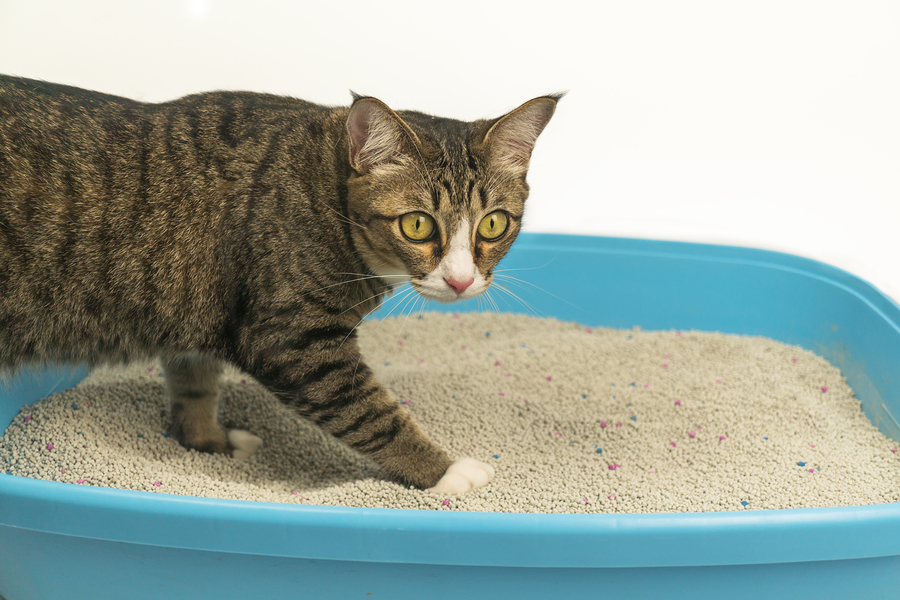Rachel Lees, RVT, KPA CTP, VTS (Behavior)
Cats are often considered a more independent, self-sufficient species compared to dogs, largely because they do not need humans to take them outside to eliminate. Most cats successfully learn to eliminate in the home by going to a litter box.
Nonetheless, feline elimination issues are one of the biggest behavioral problems clients bring to veterinarians. Often, the problem develops because human preferences regarding litter box location and type don’t match up with the desires of their feline companions.
As veterinary professionals, we must feel comfortable teaching clients what their cat wants from an elimination station. This article will review cat preferences regarding desirable locations, litter box styles, litter types, and more. This information can not only help the cat who is eliminating outside the box but can also help new kitten owners be successful from the start in setting up their new cat’s environment.
Litter Box Design and Location
Place litter boxes in safe, low-traffic areas but right off a high traffic area, so it is easily accessible. Keep them away from loud appliances such as washers and dryers, furnaces, dishwashers, air conditioners, or toilets. All these items have the potential to frighten the cat with unexpected sounds, interrupting the normal elimination pattern. An example of a safe, quiet location is a spare bedroom or bathroom that is rarely entered.
Many commercial products also offer “hidden” locations where cats can eliminate, disguised as planters or side tables, for instance. Although this hides the litter box from the human, it may also place it in a higher traffic location. Keep this in mind when giving recommendations on litter box placement. Everyone prefers privacy for elimination, even cats.
Litter box design preferences differ from cat to cat and human to human. Most cats prefer an open litter box. Most cat owners prefer a covered litter box. Covered litter boxes may trap odors and make the human environment smell better but for those reasons they may not be as desirable for the cat. If boxes are not cleaned regularly, the odor may be aversive to them.
Most commercial open litter boxes are too small for the average cat. The size of the litter box should be one and a half times the length of the cat’s body. Most veterinary behavior teams recommend using storage containers, Tupperware bins, dog litter boxes, or cement mixing pans. It is also important to find out if litter box sides are low enough for the cat to jump in without injury or pain. Using a litter box that cleans itself is typically not recommended as the sounds and machinery can scare the cat.
Litter Preferences
Many different types of litters are on the market: scented, unscented, clumping, non-clumping, wheat, newspaper, sawdust, pine, and more. A study by veterinary behaviorist Jacqueline C. Neilson DVM, DACVB, found that cats generally prefer unscented clumping litter beneath their paws. And although scented litters may be more desirable to humans, cats often disdain them. Cats are far more sensitive to odors than humans. Keep in mind as well that crystal-like litter can feel unpleasant to sensitive paws. When the cat eliminates the crystals can “pop,” causing a startling sound. Recommend giving cats the most preferable substrate—a plain, unscented litter—to set them up for success.
Since Flushing Isn’t an Option: Cleaning Tips
Litter boxes should be scooped once or twice daily. Cats prefer a clean location to eliminate. When boxes are not cleaned at least once daily, this can cause an aversion as the cat may not want to step and eliminate in a litter box filled with yesterday’s urine clumps and stool piles. Most humans would not desire this either.
To make boxes as attractive as possible, they should be emptied, cleaned with a mild, unscented detergent, and refilled with fresh litter at least once a month. Avoid cleaning the box with strongly scented cleanser.
Recommendations for Multi-Cat Homes
Design, location, cleaning, and substrate preferences are identical, but in homes with more than one cat, owners should provide one box for each cat, plus one extra. Place boxes on separate floors and rooms of the home to prevent one cat from blocking access to a box.
Keep in mind as well that using covered boxes in multi-cat homes can create increased anxiety if one cat is a stalker. If victim cats venture into the box to eliminate, they cannot see if the stalker cat is creeping up on them. If there is low-level aggression between the cats, and the victim cat is attacked when coming out of the box, the experience can create litter box aversion. For this reason, open litter boxes should be recommended in multi-cat homes.
Remember: It’s a cat’s world. We just live in it!
Author’s Note: Elimination out of the box is not always a behavioral concern and can very well be a medical cry for help. It is always important to rule out a medical condition before blaming behavior. Every patient who eliminates out of the box should be examined by a veterinarian and medically worked up (CBC/Chem/UA) before specific recommendations are made.
This article was reviewed/edited by board-certified veterinary behaviorist Dr. Kenneth Martin and/or veterinary technician specialist in behavior Debbie Martin, LVT.




